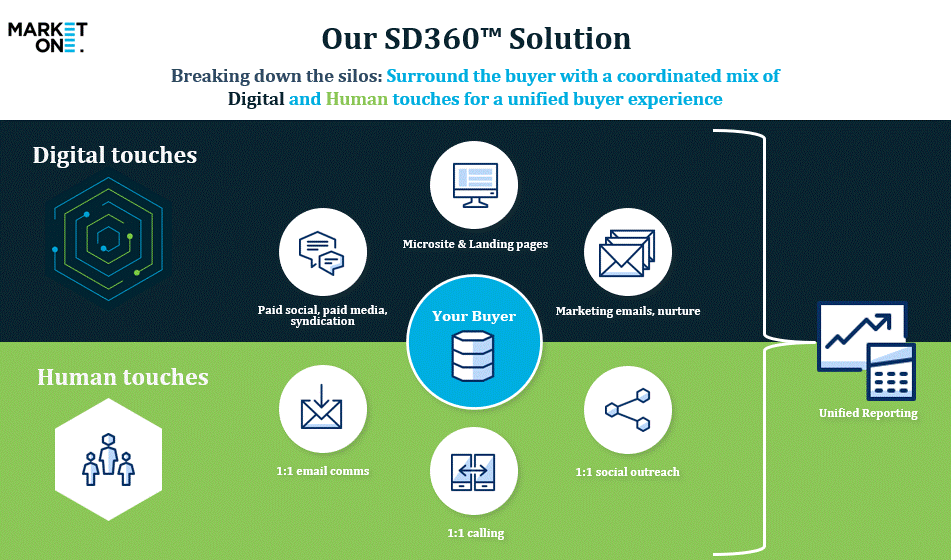“In the past couple of years, a sea change has occurred. Developing sales leads in the form of SALs or SAOs has become more and more difficult, and this means the cost of a conversion to SAL / SAO has increased dramatically.”
Fred Ewald, CEO, MarketOne
The playing field for B2B lead generation and conversion has changed. The pandemic and a greater focus on digital sources mean buyers are no longer buying in the same way. Sellers have struggled to keep up with this change, often preferring to rely on ‘more of the same’, rather than adapting to new conditions. This in turn has emphasized pre-existing flaws in the sales process, including siloed tactics and an over emphasis on the top of the funnel, rather than the more important point of conversion from MQL (marketing qualified lead) to SAL (sales accepted lead).
We’ve analyzed this challenge in detail and come up with a new sales development-driven solution called SD360™. Here’s how we got there, and how it can help your B2B business generate higher-quality leads and more conversions.
What has changed?
1. A fundamental shift in B2B buying behavior and economic uncertainty
As key decision makers are working remotely, no longer at trade shows and events, and are self-serving through digital channels, B2B businesses have had to pivot to find their buyers with arguably more expensive tactics – for example, investing in new technology and targeted and more personalized strategies. In addition, costs for materials, transportation and production are increasing for businesses, and marketing budgets have been cut, or have suffered from reduced purchasing power as they can buy fewer resources or services.
2. Increased competition for audiences and ad space
The pandemic accelerated the shift to digital marketing, driving up the cost per click (CPC) or cost per impression (CPM), which increases the cost per conversion as businesses compete for a smaller pool of potential customers. B2B ad spending will total over $35 billion in 2023, up 9.3% from 2022, according to Insider Intelligence. There’s a potential for ‘ad fatigue’ as B2B buyers tire of seeing adverts, resulting in low lower click-through rates (CTR).
3. Ad platform changes
In response to the pandemic, ad platforms including Google Ads and Facebook Ads changed their algorithms and ad policies. Google Ads cost per lead increased on average across all industries by 19% in 2022, with a dramatic decrease in conversion rate. Ninety-one per cent of industries saw their conversion rate drop on average by 14%. Google also removed modified broad match keywords and allowed advertisers to remove keyword match types altogether at campaign level. Users are clicking but intent may not be there, again lowering conversion rates.
4. Sales and marketing are run in silos
79% of marketing leaders said that their organization’s marketing and sales teams were misaligned to some degree [Salesforce].
90% of companies say that siloed teams are having a negative impact on the customer experience [InsideView].
Typically, B2B sales and marketing are still working independently with siloed business objectives, strategy, technology and budgets. For example, marketing may drive pay-per-click (PPC) campaigns to one set of landing pages, paid social to another, and marketing automation platform (MAP) nurtures to another. Sales might use outbound calling campaigns without sharing marketing content via email. A third-party appointment setting campaign could be run with sales using sales-generated emails and landing pages. We’ve also seen an increase in key account managers and directors doing their own prospecting. Sales and marketing teams may be talking to each other infrequently or not at all.
These uncoordinated and disjointed tactics result in wasted resources, duplication of efforts, inconsistent messaging which can lead to brand mistrust, missed opportunities for cross-selling, up-selling, and customer retention, and a fragmented and cumbersome buyer experience.
6. One and done, ‘one-shot’ campaigns that focus on quantity not quality
Related to the above, the one-off campaigns so often run to generate a low cost per lead and net new contact acquisition may achieve their goals, but the impact is only short-term and reinforces any existing team or tech silos. Resources are allocated to where the most leads are, irrespective of their quality, in order to keep the lead pipeline full. A wide net and lack of targeting means the actual cost per conversion can be high.
Cost per lead (CPL) programs such as content syndication and appointment setting are often seen as a solution to stay dominant in the marketplace when buyers are hard to reach – 65% of B2B marketers use content syndication as a core lead generation tactic [Salesbox]. However, the number of leads to generate a conversion to a sales qualified lead has increased dramatically. Based on MarketOne’s own experience, 10 years ago, content syndication converted to sales accepted leads (SAL) at up to 20 times higher rates than today, but this can be turned around.
What does this mean for a B2B business today?
The result of siloed marketing and sales tactics is a catalog of inefficiencies:
- A duplication of efforts by marketing and sales results in wasted time and resources and a higher cost of customer acquisition.
- A fractured, misaligned buyer experience as buyers are confused by inconsistent messaging, which leads to distrust of the brand and lower brand loyalty. Only 8% of B2B companies reported that their marketing and sales teams were tightly aligned in terms of messaging and content [Forrester Research].
- Limited follow-ups and nurturing through multiple touchpoints mean missed opportunities for sales.
- Lack of customer insight as visibility into the buyer journey is decreased.
- Inability to be agile and adapt to changing marketplace conditions or to buyer behavior.
So what’s the solution?
SD360™ is an always-on sales development and ABM engine that inputs account lists and outputs sales-ready leads (SALs), maximizing conversions into sales. We do this by unifying siloed sales and marketing touchpoints, both digital and human, providing the B2B buyer with a unified 360° experience, supporting sales and marketing efforts for your business and channel partner programs.
We saw these pain points frequently crop up for our enterprise clients, which led us to the development of our account-based, sales development solution, SD360™. By encircling the buyer with a carefully coordinated and sequenced range of touchpoints, we can reach your buyer where they are, nurturing them with targeted messaging until they show intent.

What makes this approach so special?
It’s multichannel
The prospect is surrounded with human and digital touchpoints. Each channel amplifies each other and works holistically to encircle the buyer, increasing the opportunity for engagement, even when the buyer is working remotely.
It’s always-on
We increase your brand’s visibility with a campaign that’s always on, crucially maximizing the possibility of conversion in each and every lead. This is in direct contrast with ‘one shot’ siloed campaigns where leads that haven’t converted are never followed up again. With SD360™, any ‘left over’ leads from a fixed duration marketing campaign are entered into nurture, and when they’re ready, we’re there too.
It’s data-driven
95% of marketers agree that a unified data source improves attribution [Ascend2, 2022]
The SD360™ package options (Bronze, Silver and Gold) include a dashboard to collect and collate all your data in one place, requiring no or little integration with your legacy systems. This centralized platform holds your data in one place to track real time actions and deliver accurate forecasting. The dashboard provides a single source of truth and rich unified reporting, helping to trigger the next best action for the buyer segment.
Data is not siloed in one department but shared across sales, marketing, RevOps and customer teams. This shared visibility helps everyone to make faster and more efficient business decisions through granular and accurate data without switching between platforms, so driving growth faster, uniting your business culture and saving time and resources.
It’s technology-enabled
The SD360™ martech platform can be tailored to provide a bespoke service tailored to your business. Bespoke and GDPR compliant, SD360™ uses the best and latest technology to connect and engage with your buyer.
The results: alignment and a lower cost per conversion (CPC)
Siloed, linear processes, where the baton is handed over at a specified point in the customer journey, keep B2B businesses uncompetitive with poor collaboration and trust between teams, wasted resources due to inefficiencies, reduced data quality, poor analytics and a difficult buyer experience. When silos are reduced, systems, processes, teams and data can align under the central SD360™ platform, for unified teams, unified technology, unified sales intelligence and unified reporting. The quality of leads improve and each lead is nurtured, meeting the buyer where they are along the customer journey and creating personalized experiences at scale. This, in turn, drives down the cost of conversion (CPC) for your business.
Cost per conversion has increased in recent years due to a change in buyer behavior, ad platform changes, increased competition for ad space and the same pool of buyers. SD360™ is a new, managed service from MarketOne that looks to align currently siloed teams, tactics, data and technology to drive down the cost per conversion. The cost of continuing to employ the same old marketing tactics that focus on one-off campaigns, and keeping the pipeline full, is far greater than a targeted, account-led approach, driven by sales development. When you think of it this way, taking a new approach is a no brainer.


